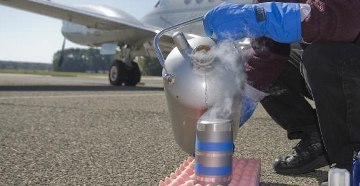|
Discovered:
In 1674 the English physician John Mayow demonstrated that air is not a single element, it is made up of different substances. He did this by showing that only a part of air is combustible. Most of it is not. (1)
Almost a century later, Scottish chemist Joseph Black carried out more detailed work on air. After removing oxygen and carbon dioxide from air, part of the air still remained. Black had used burning phosphorus as the final step in oxygen removal. {Burning phosphorus has a very high affinity for oxygen and is efficient at removing it completely.) Black assigned further study of the gases in air to his doctoral student, Daniel Rutherford. (2)
Rutherford built on Black's work and in a series of steps thoroughly removed oxygen and carbon dioxide from air. He showed that, like carbon dioxide, the residual gas could not support combustion or living organisms. Unlike the carbon dioxide, however, nitrogen was insoluble in water and alkali solutions. Rutherford reported his discovery in 1772 of noxious air, which we now call nitrogen. (3)
Swedish pharmacist Carl Scheele discovered nitrogen independently, calling it spent air. Scheele absorbed oxygen in a number of ways, including using a mixture of sulfur and iron filings and burning phosphorus. After removing the oxygen, he reported a residual gas which would not support combustion and had between two-thirds and three-quarters of the volume of the original air. Scheele published his results in 1777, although it is thought the work was carried out in 1772. (4)
Although Rutherford and Scheele are now jointly credited with nitrogen's discovery, it appears to have been discovered earlier by Henry Cavendish, but not published. Prior to 1772 (the precise date is unknown - Priestley refers to it in his work Experiments and Observations Made in and Before the Year 1772) Cavendish wrote to Joseph Priestley describing "burnt air" prepared by passing air repeatedly over red hot charcoal (removing the oxygen) and then bubbling the remaining gas through a solution of caustic potash (potassium hydroxide) which would have removed the carbon dioxide. Cavendish wrote: "The specific gravity of this air was found to differ very little from that of common air; of the two, it seemed rather lighter. It extinguished flame, and rendered common air unfit for making bodies burn in the same manner as fixed air, but in a less degree, as a candle which burnt about 80" in pure common air, and which went out immediately in common air mixed with 6/55 of fixed air, burnt about 26" in common air mixed with the same portion of this burnt air." (5)
In 1790 the French chemist Jean-Antoine-Claude Chaptal named the element "nitrogen" after experiments showed it to be a constituent of nitre, as potassium nitrate was then called.
|
